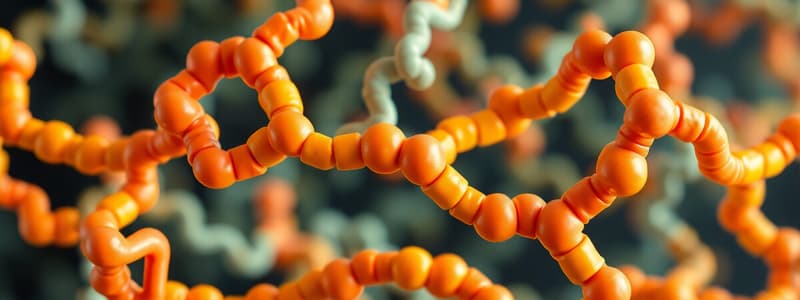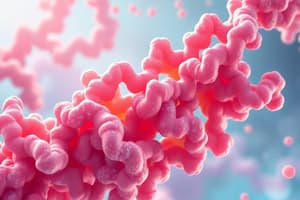Podcast
Questions and Answers
Which component of an amino acid distinguishes it from other amino acids?
Which component of an amino acid distinguishes it from other amino acids?
- Variable side chain (R-group) (correct)
- Carboxyl group
- Central alpha carbon
- Amine group
What type of reaction joins amino acids together to form a dipeptide?
What type of reaction joins amino acids together to form a dipeptide?
- Reduction
- Hydrolysis
- Oxidation
- Condensation (correct)
What is the name of the bond formed between two amino acids during protein synthesis?
What is the name of the bond formed between two amino acids during protein synthesis?
- Peptide bond (correct)
- Hydrogen bond
- Glycosidic bond
- Ester bond
Why are essential amino acids dietary requirements?
Why are essential amino acids dietary requirements?
A diet lacking one or more essential amino acids will primarily affect which process?
A diet lacking one or more essential amino acids will primarily affect which process?
What determines the primary structure of a protein?
What determines the primary structure of a protein?
How does the DNA of a cell determine the primary structure of a protein?
How does the DNA of a cell determine the primary structure of a protein?
What is the impact of a mutation that causes an incorrect amino acid to be incorporated into a polypeptide chain?
What is the impact of a mutation that causes an incorrect amino acid to be incorporated into a polypeptide chain?
What type of bond is directly responsible for the formation of alpha-helices and beta-pleated sheets in the secondary structure of a protein?
What type of bond is directly responsible for the formation of alpha-helices and beta-pleated sheets in the secondary structure of a protein?
In the secondary structure of a protein, where do hydrogen bonds typically form?
In the secondary structure of a protein, where do hydrogen bonds typically form?
Which level of protein structure is primarily stabilized by interactions between R-groups?
Which level of protein structure is primarily stabilized by interactions between R-groups?
What role do hydrophobic interactions play in shaping the tertiary structure of a protein?
What role do hydrophobic interactions play in shaping the tertiary structure of a protein?
What type of bond is formed between the R-groups of cysteine amino acids in the tertiary structure of a protein?
What type of bond is formed between the R-groups of cysteine amino acids in the tertiary structure of a protein?
How does the arrangement of polar and non-polar amino acids relate to the solubility of globular proteins in water?
How does the arrangement of polar and non-polar amino acids relate to the solubility of globular proteins in water?
Which characteristic is associated with proteins functioning as transport molecules?
Which characteristic is associated with proteins functioning as transport molecules?
What is a 'subunit' in the context of quaternary protein structure?
What is a 'subunit' in the context of quaternary protein structure?
Which of the following is an example of a conjugated protein?
Which of the following is an example of a conjugated protein?
What is the role of the heme group in hemoglobin?
What is the role of the heme group in hemoglobin?
Which of the following best describes the structure of collagen?
Which of the following best describes the structure of collagen?
What type of bonds primarily contributes to the tensile strength of collagen?
What type of bonds primarily contributes to the tensile strength of collagen?
Why are fibrous proteins like collagen typically insoluble in water?
Why are fibrous proteins like collagen typically insoluble in water?
What is the arrangement of collagen molecules in fibrils that contributes to the overall strength of the connective tissue?
What is the arrangement of collagen molecules in fibrils that contributes to the overall strength of the connective tissue?
Which structural feature is characteristic of globular proteins?
Which structural feature is characteristic of globular proteins?
Globular proteins are involved in metabolic reactions because of what property?
Globular proteins are involved in metabolic reactions because of what property?
How does the insolubility of fibrous proteins relate to their biological functions?
How does the insolubility of fibrous proteins relate to their biological functions?
Flashcards
Amino acids
Amino acids
Long chains of recurring monomers that make up proteins.
Peptide Bond
Peptide Bond
A covalent bond between two amino acids.
Polypeptides
Polypeptides
Long chains of covalently bonded amino acids.
Essential Amino Acids
Essential Amino Acids
Signup and view all the flashcards
Non-essential Amino Acids
Non-essential Amino Acids
Signup and view all the flashcards
Conditional Amino Acids
Conditional Amino Acids
Signup and view all the flashcards
Primary Structure
Primary Structure
Signup and view all the flashcards
Secondary Structure
Secondary Structure
Signup and view all the flashcards
Tertiary Structure
Tertiary Structure
Signup and view all the flashcards
Quaternary Structure
Quaternary Structure
Signup and view all the flashcards
Denaturation
Denaturation
Signup and view all the flashcards
Zwitterions
Zwitterions
Signup and view all the flashcards
R-group
R-group
Signup and view all the flashcards
Globular Proteins
Globular Proteins
Signup and view all the flashcards
Fibrous Proteins
Fibrous Proteins
Signup and view all the flashcards
Prosthetic Group
Prosthetic Group
Signup and view all the flashcards
Vegan Diets
Vegan Diets
Signup and view all the flashcards
Side Chains
Side Chains
Signup and view all the flashcards
Biological activity
Biological activity
Signup and view all the flashcards
Diverse Class
Diverse Class
Signup and view all the flashcards
Structure Proteins
Structure Proteins
Signup and view all the flashcards
Hormones Proteins
Hormones Proteins
Signup and view all the flashcards
Immunity Proteins
Immunity Proteins
Signup and view all the flashcards
Protein Transport
Protein Transport
Signup and view all the flashcards
pH Changes
pH Changes
Signup and view all the flashcards
Study Notes
Proteins Overview
- Proteins' form and function is determined by their molecular structure.
- The study of proteins covers Standard Level, Higher Level and Additional Higher Level material.
Guiding Questions for Study
- Consider how form variations enable functional diversity in carbohydrates and lipids. What is the relationship between amino acid sequence and the diversity in the function of proteins?
- Compare carbohydrates and lipids regarding energy storage. How do chemical and physical environments affect protein molecules?
Generalized Structure of an Amino Acid
- A generalized amino acid structure includes an alpha carbon atom. Attached to this are an amine group, a carboxyl group, an R-group, and a hydrogen atom.
- Proteins are composed of long chains of amino acids, which are recurring monomers.
Amino Acid Composition
- Each amino acid features a central alpha carbon linked to an amine group, carboxyl group, hydrogen atom and variable group.
- There are 20 universal amino acids found in living organisms.
- Each amino acid differs in the composition of its variable side chain, denoted as 'R'.
Forming Peptide Bonds
- Condensation reactions join amino acids, forming dipeptides and water.
- A peptide bond links the amine and carboxyl groups of adjacent amino acids.
- Polypeptides are formed from long chains of covalently bonded amino acids. They can be broken down via hydrolysis with water.
Dietary Importance of Amino Acids
- Essential amino acids, which the body cannot synthesize, have to be obtained from food.
- Non-essential amino acids, which can be synthesized by the body from other amino acids, do not need to be part of the diet.
- Conditional amino acids are not always required, but are essential at certain times such as during pregnancy, infancy, or illness.
- A shortage of one or more essential amino acids will stop the production of specific proteins.
- Lack of essential amino acids causes protein deficiency malnutrition, whose health effects vary with the amino acid shortage.
- Certain diets, such as vegan diets, require attention to ensure essential amino acids are consumed and malnutrition is avoided.
Peptide Chain Characteristics
- Twenty amino acids are coded for in the genetic code. Peptide chains range from a few to thousands of amino acids.
- Polypeptide chains are also composed of 20 different types of amino acids, each with a specific variable side chain.
- Distinct chemical properties of these side chains will hence cause the protein to fold differently within the polypeptide chain.
- Protein molecule folding determines function and the level of biological activity.
- Most natural polypeptide chains contain between 50 and 2000 amino acid residues, thus organisms can produce a huge range of possible polypeptides.
- Proteins are a diverse class of compounds and perform different roles within a cell.
Functions of Proteins
- Proteins exhibit structure via Spider silk and collagen
- Proteins exhibit as hormones via insulin and glucagon
- Proteins exhibit immunity via antibodies
- Proteins exhibit transport via protein channels
- Proteins exhibit sensation via rhodopsin
- Proteins exhibit movement via actin and myosin
- Proteins exhibit enzyme action via Rubisco and amylase
Protein Denaturation
- Denaturation is a structural change in a protein, leading to a permanent loss of its biological properties, and is influenced by pH and temperature.
- The function of a protein depends on its folding, so any change or abrogation of its three dimensional structure will alter the activity.
- Denaturation occurs due to high temperatures or changes in pH.
Temperature and Protein Structure
- High thermal energy disrupts the hydrogen bonds holding the protein together, causing it to unfold and lose function.
- Human proteins function optimally at body temperature (approximately 37ºC), but temperatures at which proteins denature may vary.
pH and Protein Structure
- Amino acids are zwitterions, possessing positively charged (NH3+) and negatively charged (COO-) regions, thus molecules are neutral.
- Altering the pH changes the protein's charge, affecting its solubility and shape.
- Proteins have an optimal pH for functioning, which depends on their environment (e.g., stomach proteins function best in acidic, blood proteins at neutral pH).
Amino Acid R-Groups
- R-groups determine the properties of assembled polypeptides and their chemical diversity.
- R-groups are either hydrophobic or hydrophilic; hydrophilic R-groups are classified as polar or charged, while acids and bases are considered as hydrophilic.
Amino Acid Diversity Explained
- Twenty amino acids make up most of the proteins on Earth.
- From around 500 natural amino acids, only 20 are common in proteins.
- Humans can synthesize eleven amino acids; the other nine must be obtained in the diet.
- R groups' chemical diversity between the 20 amino acids provides for chemical diversity.
Impact of Primary Protein Structure
- The sequence and the position of each amino acid determines the three-dimensional shape of proteins.
- Proteins possess predictable and repeatable structures due to the primary structure.
Levels of Protein Structure
- Proteins are large, complex molecules, known as polypeptides, that contain one or more amino acid chains.
- The three-dimensional arrangement of its polypeptide chains will dictate a protein's structure and its function.
- Three levels of structure refer to structural aspects of a single polypeptide chain, although there are four levels of structure in proteins.
- The fourth level relates to proteins with more than one polypeptide chain.
Primary Protein Structure
- The sequence of amino acids bonded by covalent peptide bonds is known as the primary structure.
- A cell's DNA determines a protein's primary structure, as it instructs what and how certain amino acids must be added in sequence.
- This will affect the protein's shape, and therefore, its function.
- Mutations that lead to an incorrect amino acid can affect the function of the whole polypeptide chain.
- Primary structure is specific for each protein.
Secondary Protein Structure
- Weak hydrogen bonds facilitates protein to form secondary structures within the polypeptide chain
- Within a protein, hydrogen bonds will form between carboxyl (C=O) and amino (N-H) groups.
- The change of the protein's shape usually happens due to the non-adjacent amino acids, in relation to its linear polypeptide chain.
- These hydrogen bonds allow proteins to form two shapes: beta-pleated sheets and alpha-helix;
Tertiary Structure
- R group interactions are relevant to how both non-polar and polar amino acids form chemical bonds.
- The polypeptide forms into a three-dimensional shape complex known as the tertiary structure whose folding determines the function.
- On the cell membranes and active sites in enzymes, tertiary structures allow the protein to have receptor sites for its function.
- R group interactions are the components where the protein's surroundings are a result of the chemical bonds.
- Hydrogen bonds in the amino acids form tertiary structures that make polar R-groups join. Because the hydrophobic R-groups will not have any contact with water, hydrophobic interactions allow the proteins to stay within, as the non-polar R-groups bond.
Protein Bonds & Interactions
- Covalent bonds will form as tertiary structure due to the R-groups and amino acids joining. Because positively/negatively charged R-groups form ions, R-groups are what can become charged through hydrogen.
Amino Acids
- Amino acids are polar or non-polar depending on their R-groups.
- Proteins become less soluble in the cytoplasm (aqueous solutions) when composed of non-polar compounds and amino acids.
- Proteins are composed for structural purposes (stationary) and can found in the active site (lipase enzymes) of cells (glycoproteins).
- Proteins will be localized or found on the surface due to non-polar or polar compounds.
- Soluble proteins found in different spots within a cell, capable of interacting with water (hydrophilic channels/membranes/ aqueous environments).
Protein Quaternary Structures
- Multiple polypeptide chains must work together to make a protein that can be seen as a larger and functional macromolecule. Because polypeptide chains have repeating subunits, a protein can only have its specific quaternary structure after the components have related and closely functioned to its purpose.
- The two different proteins that are non-conjugated are Insulin and Collagen. They are non-protein components.
- Hemoglobin is one of the best examples of conjugated proteins which contains 2 pairs of globins(polypeptide chains) with four subunits containing the heme group(iron ion).
Pleating and Coiling
- Hydrogen bonding in positions that allow stabilization of Alpha helices + pleated sheets are important to proteins' secondary structure.
X-Ray crystallography
- Protein-related structures that are too "impossible" to observe can be observed in unaided senses by utilizing single, more advanced modern tech. Ex: Cryogenic Electron Microscopy
- Tech involving X-Ray crystallography are useful in observing structures of proteins to rapid freeze those proteins in liquid and analyze them for microscopy with high resolution.
- 3D shapes of proteins will allow the understanding how the protein will interact with molecules involved in its environment, allowing for better accuracy. -Depending on the molecule/protein, the type of protein that will be studied will determine the tech's applications.
Fibrous vs Globular Protein
- Scientists can find the relationship of globular and fibrous proteins, to better understand their overall shape and understand their specific roles. Use collagen + insulin to define how the two relate.
- Globular proteins have a general "spherical shape" with water to hold its liquid.
- Fibrous proteins have long polypeptide chain strand links and are not dissolvable in water.
- Globular proteins change shape for their tertiary because non-polar hydrophobes are repelled out and polar hydrophiles have the R-groups on its outer form.
- The tertiary of the polypeptide chains allows water molecules to attach proteins, enabling the liquid for proteins.
- The water-soluble liquid and polypeptide chains allows physiological roles in metabolic reactions to transfer easier in organisms.
- Enzyme + Immunoglobulins can respond antigens, therefore, proteins can have their distinct shapes because of R-groups interacting.
- Haemoglobin is a great example of the prosthetic/conjugated structure that has the "haem" prosthetic group(name is called that).
Insulin Hormones
- Insulin (hormone itself) has its sequence determined by hormone and scientists. The liquid is produced in proteins while balancing and reacting with blood in the pancreas. Two linked chains of polypeptide B/A hold the insulin together. (21 amino acides/30 residues)
Fibrous Proteins
- Strong organization/highly repetitive sequences are useful and allows proteins to have their structural support in liquid along connective tissues (Keratin example). The liquid form depends on how many hydrophobic R-groups there can be, which will determine or alter any tertiary structure.
Collagen Details
- Protein that's known to be structured in the forms we know, found in tendons, skin, ligaments, cartilage, teeth, bones, eye Cornea/walls of blood vessels. Collagen's structure (triple helix) is linked by forming insoluble protein that's connected to 3 chains held by hydrogen, gives a high "tensile strength", with bonds containing 1000 amino acids. This chain will be in contact alongside hydrogen, for stronger bonds. The shape in collagen helps strengthen the molecule through strands of amino acids forming parallel contact with the cross-links to have staggered ends that "line up" and resist external forces.
Studying That Suits You
Use AI to generate personalized quizzes and flashcards to suit your learning preferences.




